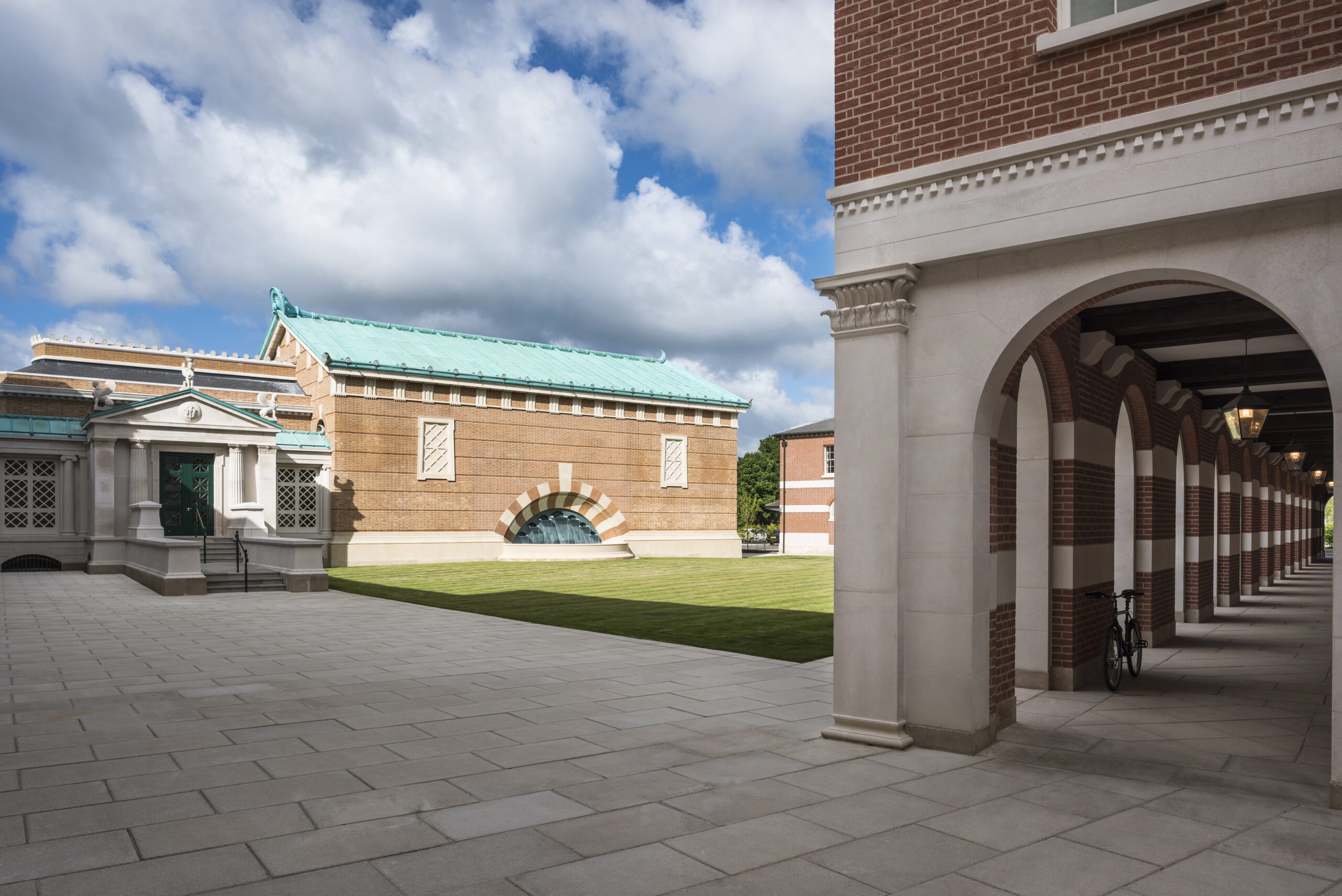The Timeless Language of Classicism
Wednesday, March 13, 2024 12:00 pm EST

As one of the world’s leading practitioners of New Classicism, John Simpson has revolutionized the combination of durability, functionality, and beauty within his projects. John Simpson’s design philosophy centers on the idea that architecture is a public art, shaping the character of streets, squares, and civic spaces to influence our collective cultural experience. In this lecture, Simpson will highlight small-scale residential apartment designs, country houses, large-scale institutional projects and more that exemplify functional design. This event was recorded on February 21, 2024.
In the second part of the School of Architecture’s “Restoring Reason, Beauty, and Faith in Architecture”, architect John Simpson, recognized for his traditional yet innovative approach to architecture, discussed the significance of classicism in modern urban development, the impact of Prince Charles’s School of Architecture on his work, and the intricate balance between incorporating historical context and meeting contemporary needs. Host Dean Stefanos Polyzoides, of the Notre Dame School of Architecture, powerfully introduced Simpson’s renowned architectural background, and his unique connection to the University of Notre Dame as the architect of the Walsh Family Hall, which houses the School of Architecture.
The lecture began with a discussion on sustainable urban development, with Simpson exemplifying his philosophy through the detailed design of Poundbury and other settlements. He highlighted the intentional reduction of motor vehicle reliance, drawing upon political interest in modeling new urban extensions after traditional towns. Despite the challenges faced, Simpson’s firm designed functional and inclusive spaces, underscoring the importance of creating a sense of place and ensuring architecture’s belonging within the community fabric.
Detailing the creation of design codes that capture the essence of local vernacular architecture was another key point of Simpson’s approach. In doing so, he emphasized the significance of tradition in informing design choices, ensuring continuity and a sense of place. This was underlined by the narrative of stewarding Raymond Areth’s architectural vision into the present, which involved not merely reconstructing past designs but weaving them into a coherent contemporary community space.
Simpson’s discussion also touched upon the task of revitalizing the Royal College of Music in London, where he maintained architectural continuity while updating the space to suit modern needs, such as acoustics for performance spaces. The project presented an opportunity to enhance the social atmosphere for students and return to the simplicity of the original plan, negotiating the complex circulation routes within the college.
The importance of craftsmanship also featured prominently in Simpson’s dialogue; he illuminated the collaborative nature of bringing architectural designs to fruition. Celebrating the role of skilled craftspeople, he shared the intricate interplay between functional and aesthetic elements that define the character of a building – lanterns, chimneys, stone dressings – and harmonize with their gothic or classical settings.
Within the final pillars of the episode, Simpson reflected on the broader application of his firm’s work. He highlighted the value of designs that adapt to existing constraints while contemplating future changes. This was exemplified by projects such as Peter House in Cambridge and Lady Margaret Hall at Oxford, where the designs had to reconcile with existing architectural elements to ensure a seamless integration with the historical context.
As the episode closed, the audience was left with a profound understanding of the evolving character of architecture and how it balances the tangible with the visionary. Simpson’s work embodied a methodical yet creative process that honored traditional design elements while infusing them with modern functionality.
The Beauty of Sustainable Urban Development [08:00]: The fusion of traditional aesthetics with sustainable innovations serves as a poignant reminder that progress need not come at the expense of beauty. Simpson’s work in creating new settlements like Poundbury instills the idea that green and traditional urban spaces can coexist harmoniously, providing functional beauty. This challenges us to rethink urban planning and development in our own communities by seeking methods that honor both our heritage and our responsibility to the environment.
Time, Tradition, and Design Diversity [07:00]: Simpson’s work is a testament to the idea that architectural design should capture the spirit of the times while also respecting tradition. The variety found in his work serves as a lesson in integrating one’s unique contributions within a larger historical context. It encourages us to embrace innovation while remaining mindful of the legacy we are building upon, whether in creative projects, career pathways, or personal growth.
Future-Proofing Our Creations [31:00]: Designing with future flexibility highlights an essential principle: the best designs anticipate and adapt to change. This “ah-ha” moment pushes us to think long-term in our undertakings, ensuring that what we build—whether structures or strategies—is resilient and open to evolution. It’s a call to consider the legacy of our actions and their adaptability to the demands of the future.
Balancing Aesthetics and Economics [55:00]: The challenge of balancing beauty with budget is a universal concern. Simpson’s architectural endeavors demonstrate that resourcefulness and creativity can achieve aesthetic excellence without exorbitant costs. This insight is heartening for anyone striving to make a meaningful impact without unlimited resources, affirming the possibility of innovation within budget constraints.
Sustainable Building for Tomorrow [01:02:00]: Reflecting on past mistakes in unsustainable designs, like those critiqued in Paternoster Square, provides a moment of accountability. It reinforces the importance of adopting a sustainable mindset in all our endeavors, from construction to daily lifestyle choices. It’s an admonition to learn from history and make decisions that pave the way for a healthier planet.
The Impact of Context in Design [01:07:00]: A building’s context profoundly influences its design, a notion applicable to various life aspects. Whether in the personal or professional domain, acknowledging the impact of context encourages nuanced and empathetic approaches. It informs us to be mindful of our environments and to adapt our initiatives according to the cultural, economic, and social milieu.
Harmony in Diversity [46:00]: Lastly, the principle of creating unity through variety in architecture serves as a compelling metaphor for wider applications. Embracing diversity while seeking common ground can foster unity and strength in communities, teams, and societal structures. It prompts us to find cohesion in diversity, recognizing that a chorus of distinct voices can create a harmonious and powerful symphony.
- The Essence of Architectural Design: The most beautiful thing about architectural design, is the fact that ideas get born in the mind. They’re born about this size, maybe– maybe, it’s a piece of paper, right? As a diagram. And then they grow, and they grow. And then, one day, one walks through a frame and this enormous building in place that has come out of that magical seed.”
— Dean Stefanos Polyzoides [00:02:55 → 00:03:30]
- Urban Planning and Architectural Innovation: “He [John Simpson] pioneered mixed use urban planning long before it was adopted as government policy in the UK. And these are very radical issues, I think, to appreciate and understand.”
— Dean Stefanos Polyzoides [00:00:54 → 00:01:04]
- Innovative Architectural Design: “And then you can design in the traditional manner, but you don’t necessarily have to design something which has been seen before. You can always put it together in a different sort of way so that it appears fresh. And you really have to do that, because every generation wants to feel and wants to make the tradition their own.”
— John Simpson [00:21:46 → 00:22:08]
- Architectural Integration and Legacy: “Another thing that I am a great believer in is that when designing a new building, you need to take cues from the buildings around you, designed by your predecessors. This is essential to ensuring that the work of many hands that’s done over sometimes hundreds of years results in something which is coherent. I also believe that you, as the designer, need to consider what cues you need to leave behind and build into your building to make sure that future architects also adhere to what you’re intending to do. And they can pick up on that.”
— John Simpson [00:28:57 → 00:29:32]
- Innovative Architecture Education: “If you’ve got a school of architecture, you’re trying to build something that the students could actually learn from. It was quite important to build not just one type of building, but different types of buildings. The kind of criteria and hierarchy of principles that we would use to design a major civic building or a utilitarian building are different.”
— John Simpson [01:05:49 → 01:06:20]
- Sustainable Urban Design: “And it was really the whole drive towards sustainability which helped us a great deal after this. Politicians got interested in the whole thing and the whole idea of reducing the reliance on the motor car became very significant, certainly in England.”
— John Simpson [00:09:39 → 00:09:58]
- Sustainable Architecture and Design: “You can design [solar collectors] in so they don’t ruin the architecture of your building, as we did here at Lady Margaret Hall.”
— John Simpson [00:19:59 → 00:20:06]
- Perspectives on Architectural Traditions and Modernity: “In the United Kingdom, there is a great tradition of taking the long term view, particularly with institutions like Oxford and Cambridge Colleges. It might cost you more in the first place, but you then don’t have to spend the same amount of money later on, either renewing it or refurbishing it or adding to it or upgrading it.”
— John Simpson [01:02:40 → 01:02:51]
Related Content
Climate Change and The Limits of Narrative
Join the Kellogg Institute for the introductory session of a workshop refining Kellogg Faculty Fellow Roy Scranton’s draft book project “Ethical Pessimism: Climate Change and...
View EventA Brave New World of AI Governance
Explore the connection between data, geopolitics and governance, regulation, self-regulation while discovering examples of good and bad practices in various sectors, such as...
View EventAlgorethics: potentiality and challenges in the age of AI
Explore the possibilities and challenges in ethical governance of AI through algorethics. Algorethics is a term that has been developed since 2018 to denote the need for a study...
View Event

